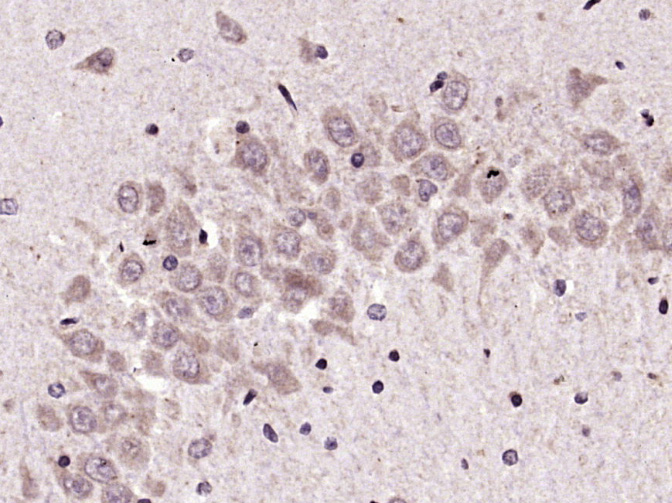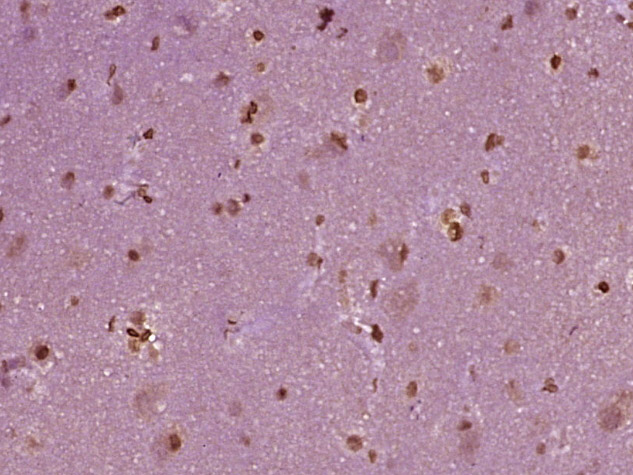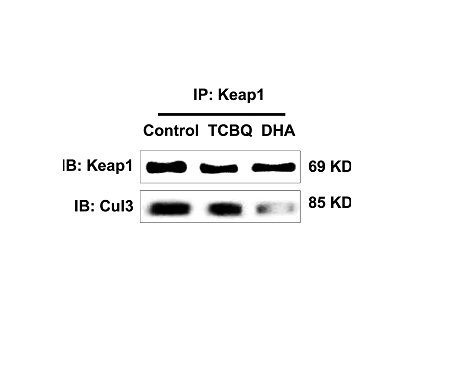
Paraformaldehyde-fixed, paraffin embedded Mouse brain; Antigen retrieval by boiling in sodium citrate buffer (pH6.0) for 15min; Block endogenous peroxidase by 3% hydrogen peroxide for 20 minutes; Blocking buffer (normal goat serum) at 37°C for 30min; Antibody incubation with KEAP1 Polyclonal Antibody, Unconjugated (bs-3648R) at 1:400 overnight at 4°C, DAB staining.
KEAP1 Polyclonal Antibody
BS-3648R
ApplicationsImmunoFluorescence, Western Blot, ELISA, ImmunoCytoChemistry, ImmunoHistoChemistry, ImmunoHistoChemistry Frozen, ImmunoHistoChemistry Paraffin
Product group Antibodies
TargetKEAP1
Overview
- SupplierBioss
- Product NameKEAP1 Polyclonal Antibody
- Delivery Days Customer16
- ApplicationsImmunoFluorescence, Western Blot, ELISA, ImmunoCytoChemistry, ImmunoHistoChemistry, ImmunoHistoChemistry Frozen, ImmunoHistoChemistry Paraffin
- Applications SupplierWB(1:300-5000), ELISA(1:500-1000), IHC-P(1:200-400), IHC-F(1:100-500), IF(IHC-P)(1:50-200), IF(IHC-F)(1:50-200), IF(ICC)(1:50-200)
- CertificationResearch Use Only
- ClonalityPolyclonal
- Concentration1 ug/ul
- ConjugateUnconjugated
- Gene ID9817
- Target nameKEAP1
- Target descriptionkelch like ECH associated protein 1
- Target synonymsINrf2, KLHL19, kelch-like ECH-associated protein 1, KEAP1 delta C, cytosolic inhibitor of Nrf2, kelch-like family member 19, kelch-like protein 19
- HostRabbit
- IsotypeIgG
- Protein IDQ14145
- Protein NameKelch-like ECH-associated protein 1
- Storage Instruction-20°C
- UNSPSC12352203
References
- Zhao Y, Li MZ, Shen Y, et al. Lycopene Prevents DEHP-Induced Leydig Cell Damage with the Nrf2 Antioxidant Signaling Pathway in Mice. J Agric Food Chem. 2020,68(7):2031-2040. doi: 10.1021/acs.jafc.9b06882Read this paper
- Kacar S, Sahinturk V, Kutlu HM. Effect of acrylamide on BEAS-2B normal human lung cells: Cytotoxic, oxidative, apoptotic and morphometric analysis. Acta Histochem. 2019,121(5):595-603. doi: 10.1016/j.acthis.2019.05.005Read this paper
- Meng Q, Guo T, Li G, et al. Dietary resveratrol improves antioxidant status of sows and piglets and regulates antioxidant gene expression in placenta by Keap1-Nrf2 pathway and Sirt1. J Anim Sci Biotechnol. 2018,9:34. doi: 10.1186/s40104-018-0248-yRead this paper
- Kouam AF, Yuan F, Njayou FN, et al. Induction of Mkp-1 and Nuclear Translocation of Nrf2 by Limonoids from Khaya grandifoliola C.DC Protect L-02 Hepatocytes against Acetaminophen-Induced Hepatotoxicity. Front Pharmacol. 2017,8:653. doi: 10.3389/fphar.2017.00653Read this paper
- Su C, Liu Z, Wang Y, et al. The electrophilic character of quinones is essential for the suppression of Bach1. Toxicology. 2017,387:17-26. doi: 10.1016/j.tox.2017.06.006Read this paper
- Chen YH, Lin WW, Liu CS, et al. Caveolin-1 Expression Ameliorates Nephrotic Damage in a Rabbit Model of Cholesterol-Induced Hypercholesterolemia. PLoS One. 2016,11(4):e0154210. doi: 10.1371/journal.pone.0154210Read this paper
- Su C, Zhang P, Song X, et al. Tetrachlorobenzoquinone activates Nrf2 signaling by Keap1 cross-linking and ubiquitin translocation but not Keap1-Cullin3 complex dissociation. Chem Res Toxicol. 2015,28(4):765-74. doi: 10.1021/tx500513vRead this paper








